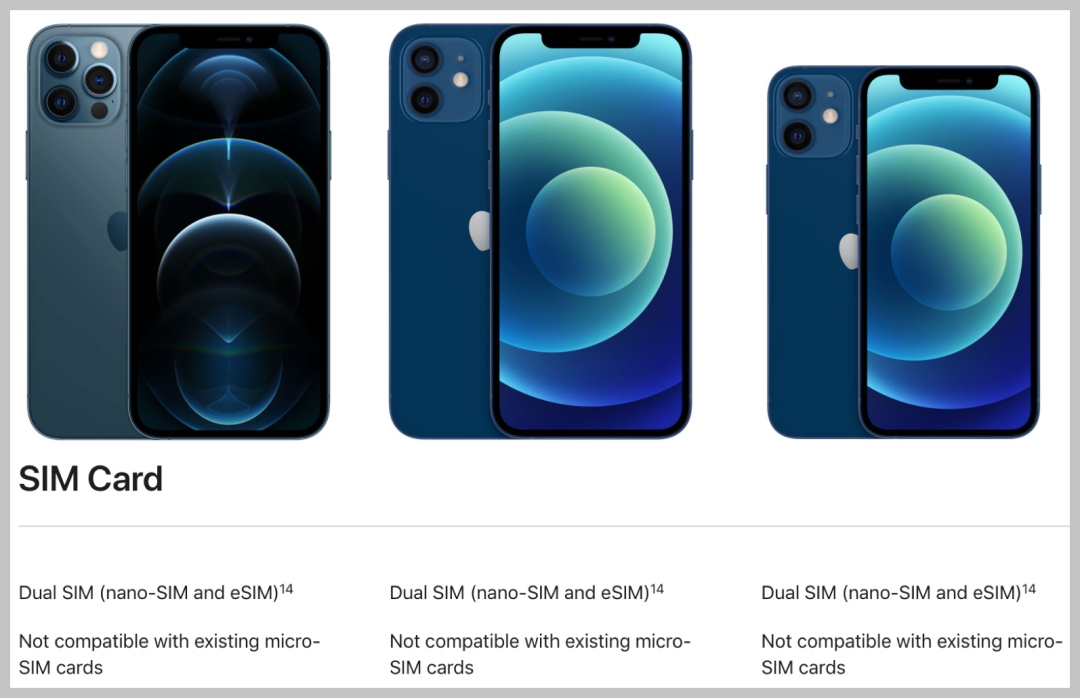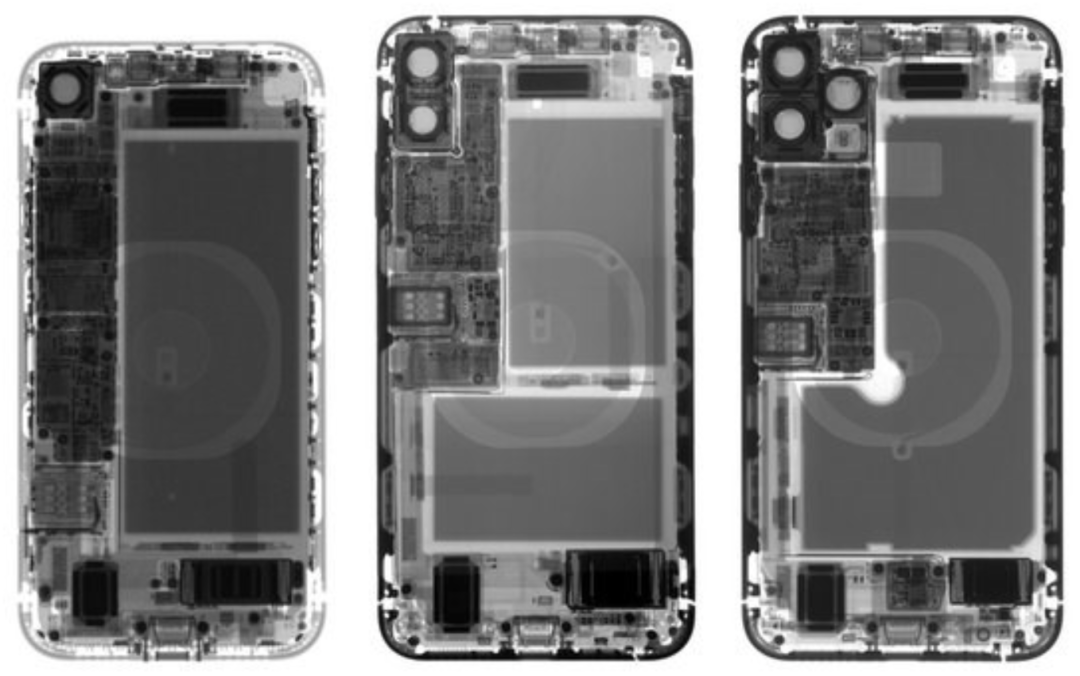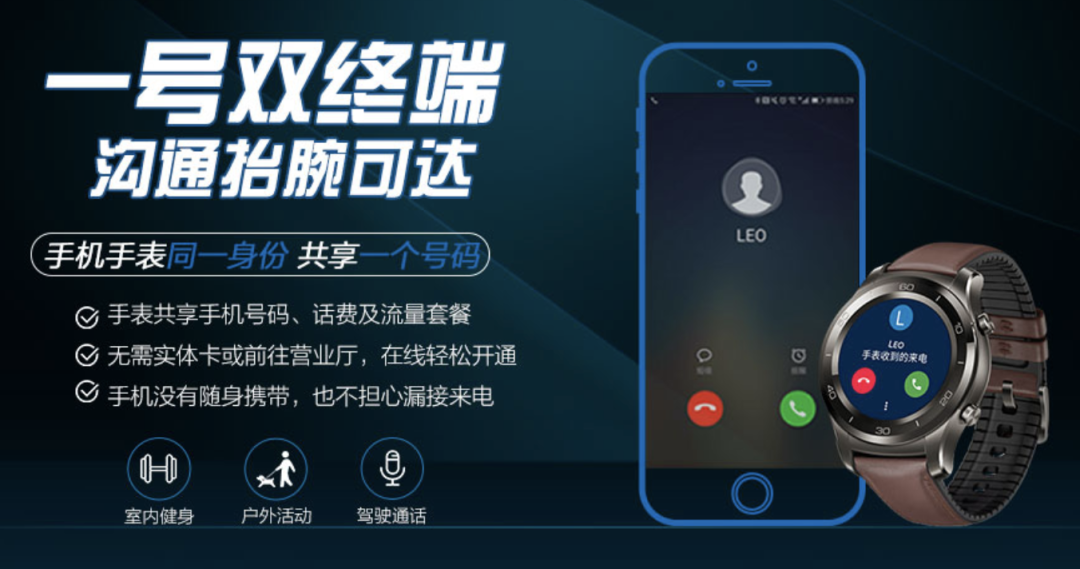Small size, big future
Editor’s note: This article is from the WeChat public account “Love Faner” (ID: ifanr), author: Zhu Hai.
After the release of the iPhone 12 series mobile phones, the iPhone 12 mini attracted the attention of many “small screen parties”. They rushed to Apple’s official website “with money”, but found that the iPhone 12 mini is a single-card mobile phone and can only choose ” Certainly next time.”
That’s not right. Didn’t you say that the iPhone 12 mini is a dual-SIM phone?
It turns out that although they are all iPhone 12 mini, they are quite different. The mainland version of the iPhone 12 mini is a physical SIM single-card mobile phone, and the US version of the iPhone 12 mini is a physical SIM card plus an eSIM dual-SIM mobile phone.
According to Apple’s official website in the United States, the iPhone 12 series phones are all physical SIM + eSIM dual cards
Recently, the Ministry of Industry and Information Technology issued an approval document, agreeing to China Mobile, China TelecomXinkai exhibited eSIM technology application services in the Internet of Things and other fields, while China China Unicom’s eSIM service was licensed as early as the beginning of this year. So far, all the three major operators have obtained the “red-head file” of the eSIM service, which indicates that eSIM will be popularized in China.
Why are mobile phone manufacturers and operators represented by Apple promoting eSIM cards?
What is eSIM?
Comparison of SIM card and eSIM card. Image source: Electronic Audiophile Network
eSIM card (Embedded-SIM) is an embedded micro SIM card. It directly embeds the traditional SIM card on the device chip without adding it to the device as an independent removable component, which solves many “pain points” of the physical SIM card.
According to the current eSIM card technical standards, in theory, the most direct benefit of eSIM card for users is to allow users to flexibly choose carrier packages, or to change carriers at any time without unlocking the device or purchasing a new device.
Currently, eSIM cards are mainly used in terminals such as smart phones, smart watches, smart home appliances, and Internet of Things devices.
With a SIM card, why do I need to do an eSIM?
When you see eSIM, many people think of SIM cards. That’s right, eSIM is a more advanced evolution of the SIM card.
First, let’s take a look at the SIM card. The Chinese for the SIM card (Subscriber Identity Module) is “User Identity Module”. It looks small in size, but it can achieve many important functions, such as short storage Letters data and phone numbers, provided User identity authentication, security algorithm and key function, etc..
Familiar physical SIM card, card slot and card pin
However, SIM cards have many disadvantages.
1. Take up valuable space inside smart devices
The internal design integration of smart devices is getting higher and higher. In order to plug in larger camera modules and batteries, various mobile phone manufacturers are doing everything possible to “eat dry and squeeze out” every little space in the mobile phone. In order to save space, we cut the original SIM card to become smaller and smaller.
The internal structure of the iPhone 11 series mobile phone shows through perspective, and the internal hardware integration and space utilization are quite high. Image source: iFixit
2. Inconvenient replacement and storage
A few days ago, I had to change a SIM card for my mobile phone. After borrowing it all around, my colleagues couldn’t find the pin. Finally, I rummaged through several cell phone boxes in the warehouse before finding a pin.
When I was about to change a new SIM card, I found that the new SIM on the desk fell on the floor under the desk. It might have been accidentally removed when I got up.
The SIM card is not only troublesome to replace, but also easy to lose.
3. Increase the production cost of smart devices
In order to insert the SIM card into the body, the smart device has to make a slot to place the card tray, which invisibly increases the design cost, the visual effect is not beautiful, and even there are additional risks-due to process design issues, Some mobile phone users mistakenly believe that the microphone hole is the SIM card holder hole, and the microphone is broken.
The SIM card slot on the side of iPhone 12 Pro. Picture from: Apple’s official website
4. Insufficient flexibility
Currently, the application and cancellation of SIM, as well as the corresponding package processing, are complicated in most scenarios, and the rights of users have not been well reflected.
Even under the premise that the country clearly promotes the number portability transfer service, many users still find that some operators have set up some obstacles before and after the number portability transfer due to different SIM card formats, which affects the actual experience.
Because of seeing the pain points of users, some software manufacturers also want to use eSIM cards to enter the office and develop telecom operations smartly.
Therefore, the SIM card has almost become a “public enemy”. The factory doesn’t like it, the hardware manufacturer doesn’t like it, the user doesn’t like it, and even some software manufacturers and communication equipment manufacturers don’t like it. The birth of the eSIM card can be said to be well received.
eSIM has many advantages and is environmentally friendly
eSIM theoretically basically solves the shortcomings of the SIM card.
1. It is smaller, further saving space.
Take Infineon’s 5G eSIM solution OC1110 as an example, the package size of eSIM is about 96% smaller than that of Nano SIM card.
In the future development of eSIM card, there will also be eSIM SIP form and eSIM SOC form. The eSIM is concentrated in the baseband, and the volume will be further reduced.
Infineon has launched the world’s first industrial-grade eSIM card with a micro-package. Picture from: Electronic enthusiast website
2. It is integrated inside the fuselage, so there is no problem of replacement and storage.
It is foreseeable that as long as eSIM cards are used on a large scale, card pins and card slots will become a thing of the past, and the card cutting business will disappear.
3. The process design cost of the smart device is further reduced, and there is no need to slot the tray, the integration degree is higher, and it is also conducive to waterproof and dustproof.
For example, the cellular version of Apple Watch does not have a physical SIM card slot, and its waterproof performance greatly exceeds that of the iPhone, reaching a maximum water resistance of 50 meters. If a physical SIM card design is adopted, whether such a high level of waterproof can be achieved is a big question mark.
The Apple Watch without a physical SIM card slot is water resistant up to 50 meters. Picture from: Apple’s official website
4. In theory, the eSIM card can switch operators and packages flexibly, but whether it can be achieved in the end depends on the relevant national regulations and the openness of operators.
Currently, a more feasible solution is that when we enter other countries or regions with a mobile phone with eSIM card function, we no longer need to find a local operator to open a physical SIM card, and we can apply directly on the mobile phone. When you leave, you can disable or log out on your phone.
In addition, the promotion of eSIM cards is also conducive to environmental protection. Physical SIM cards and their packaging need to consume plastic, metal, and paper. One eSIM card is equivalent to countless cards before, which reduces a lot of resource consumption.
In 5G and the Internet of Things, eSIM has a lot of imagination
At present, everyone is concerned about the “convenience problem” brought by eSIM. Can you let yourselfChange telecom packages or operators more freely.
If we look further, we will find that the various advantages of eSIM cards make it more applicable, wearable devices, smart home appliances, automobiles and even industrial Internet of Things can have its presence. .
Smart watches such as Apple Watch, Huawei Watch, OPPO Watch, etc., some models are equipped with eSIM cards, and they are also praised by users in the pilot use of eSIM. The frequency of users carrying or using mobile phones when going out is reduced, which is very important for large-screen mobile phone users. It’s a lot more convenient.
When the smart wearable device is connected to the Internet (such as connecting to Bluetooth, WiFi or opening eSIM), some operations on the mobile phone can be performed. Reduce the frequency of picking up the phone. Picture from: Apple’s official website
In terms of automobiles, driverless driving is one of the promising directions for people. With eSIM and 5G, the reliability of unmanned driving will be more guaranteed. The eSIM card is integrated in the car. In case of an emergency such as a car accident, the possibility of the eSIM loosening and falling off is theoretically lower than that of a physical SIM card. The eSIM does not need to be replaced manually as the communication standard or service provider changes like a physical SIM card, only software updates are required.
In the aspect of industrial Internet, eSIM can be very effective. For example, street lights, traffic lights, water and electricity meters, etc. also have networking requirements, but the cost of rewiring to connect to the network is too high, and the stability of WiFi connection is difficult to guarantee. Physical SIM card cards The groove design is also difficult to reliably waterproof under wind and sun, and subsequent maintenance is also a big problem.
The eSIM card can solve these problems theoretically. At the same time, after the product is damaged, it can be gradually replaced with a product with eSIM function after the product is damaged. The network function is realized, and the subsequent maintenance cost is relatively low.
Take the water and electricity meter as an example, manually copy Water meter is almost hard to see. The water meter will automatically upload data when it expires and remind The user pays on the mobile phone.
There are also traffic lights. With eSIM and 5G, the control of traffic lights will be more intelligent after 5G linkage. Knowing how to schedule is the best solution, reducing unnecessary waiting time for parking.
Because the traffic lights have networking and computing capabilities, their dependence on physical pipelines will be reduced, and pipeline burial can be simplified to a certain extent. In scenarios where pipelines cannot be buried, such as mobile traffic lights temporarily set during holidays and holidays, if they have eSIM functions, they will not be so “rigid” as they are now. Only one traffic light switching time can be fixed.
eSIM is good or not, promotion is not optimistic
At present, it is still difficult to activate eSIM service for mobile phones in China, and it can only be activated on specific conditions and specific devices.
For example, smart watches with eSIM cards, mobile phones with eSIM cards used by overseas students returning home, etc. can open eSIM. The business scale is much smaller than that of ordinary mobile phone SIM card services.
China Mobile’s No. 1 dual terminal eSIM service. Picture from: China Mobile official website
Take the cellular version of Apple Watch to open the No.1 dual-terminal service as an example. Users only need to enter the Watch app on the iPhone, follow the operator’s prompts, and then they can activate the service without going to the business hall. The monthly fee is generally 10 yuan/month. At the same time, there are many restrictions, such as non-pilot or unopened cities that cannot be opened, and the mobile phone must have a SIM card of the same operator before it can be opened.
From the launch of the pilot function to the official opening now, after about two years, the progress of eSIM card promotion can be said to be a bit slow. Regarding the reasons for the slow promotion, there is no official statement so far. There are many statements on the Internet. We have sorted out the main points.
1. Cost factors
Some people believe that the obvious cost advantage of eSIM does not mean simply switching to eSIM. A lot of work is needed in the internal design of smart devices, adjustment of the industrial chain, and support from operators. It is the cost, and it is not a small threshold. It requires all industries to work together.
The mobile phone still relies on the existence of the SIM card, the card slot and the card pin. If the SIM card is changed, there are many chain changes. Picture from: @brett_jordan (Unsplash)
2. Operator’s Factors
Some people believe that once the potential of eSIM is fully opened up, users can freely choose and switch between operators and telecom packages. This is unwilling for operators to see, so they have been reluctant to advance.
However, judging from the three domestic operators’ proactive attempts to develop eSIM services in recent years, this statement is untenable. For example, Fruit business is really afraid that eSIM will affect its status, and it can be done from other aspects such as handling review rules To start, there is no need to strive for the pilot eSIM business. Of course, some people think that operators are “passively” conducting business.
3. Technical Factors
Some people believe that in the past few years, eSIM still had many technical difficulties that could not be overcome. eSIM can repeatedly activate and deregister packages, and how to accurately identify the user’s true identity is a difficult problem. If eSIM is cracked by criminals and used for spam promotion or fraud, there will be a certain degree of difficulty in supervision. Now that the eSIM card has undergone several years of piloting and technological improvement, the problems have been overcome,It was not fully promoted until the Ministry of Industry and Information Technology approved it.
Conceptual changes brought about by eSIM
Compared with the SIM card, eSIM is smaller and easier to integrate into small devices. In theory, it can make more items “smart”, which will have a very large impact on the user’s mind, which is possible to a certain extent Further eliminate the “central” status of smartphones.
The decentralization of mobile phones is an inevitable trend and a good trend.
Take the iPhone as an example. Its health record and communication functions have been stripped away by the Apple Watch with eSIM to a certain extent, and its audio-visual experience has been stripped away by AirPods to a certain extent (wired headsets are only detachable and are essentially part of the mobile phone. , Bluetooth headset is an independent individual), its visual output may be stripped off by smart glasses in the future, and so on. As long as these peripheral devices can be built-in eSIM to exist independently and there is no artificial barrier to use, through 5G technology, most of the calculation and processing are given to the cloud server, and the frequency of mobile phone use will be greatly reduced.
eSIM is getting smaller and smaller, and its integration is getting higher and higher, paving the way for the Internet of Everything, and the network and computing power are no longer It is exclusive to smartphones. Picture from: @Chuncun (知识)
The reason why this is a good trend is that if the mobile phone is the center, there will be limitations in terms of smart experience. While enjoying the advantages of a certain mobile phone, one can only passively accept the shortcomings of it and its peripheral devices. If the functions of a smartphone are dispersed by devices with eSIM functions and become several independent demand carriers, the user’s choice will be greatly improved, and the overall experience will be much better, and it will not be affected by a single product ecosystem. Bundle”.
Perhaps in the near future, more and more people will go out without their mobile phones, and they can travel lightly with brand A smart headphones, brand B smart watches, brand C smart glasses, and brand D smart bicycles.
In a few decades, maybe the child sees an “old thing” without internet function, and may ask a question like: Is it broken?
*The source of the cover image of the article: Electronic enthusiast network










